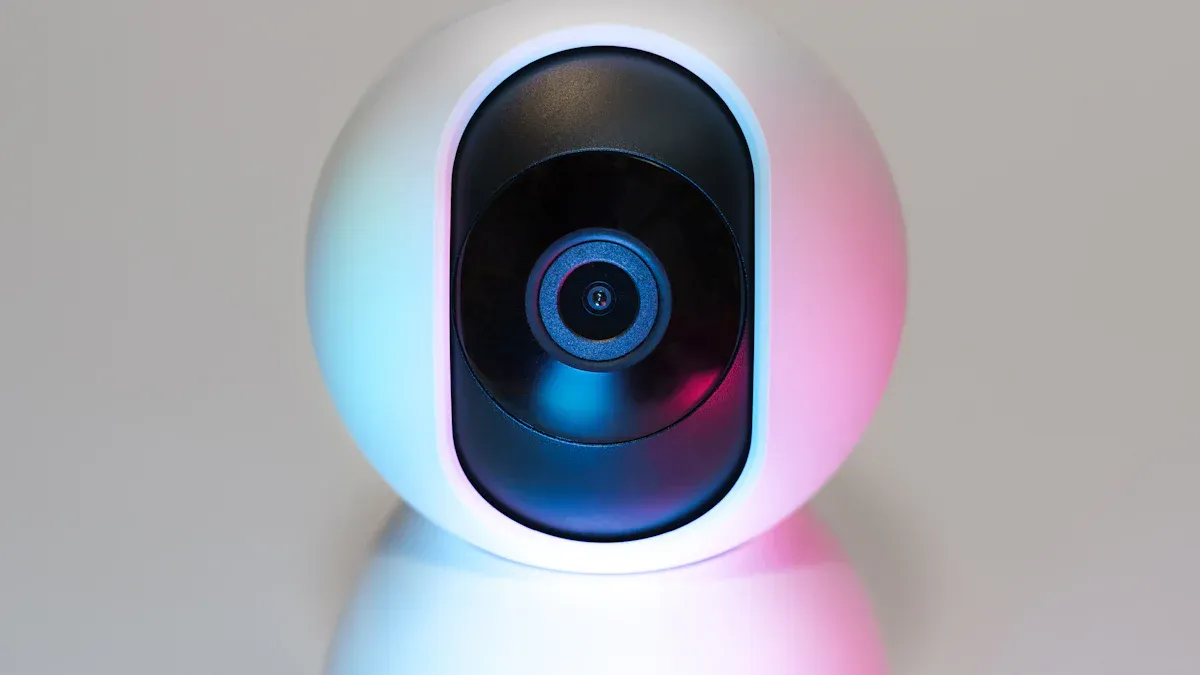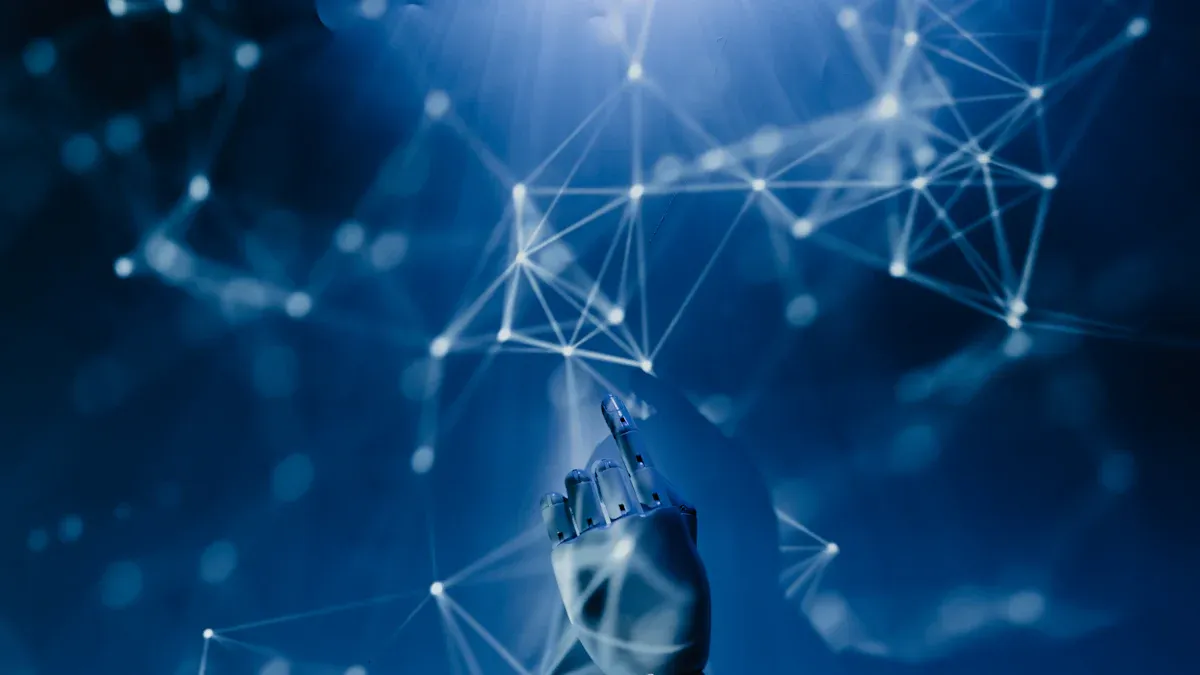
The year 2025 marks a turning point for face recognition technology, driven by breakthroughs in machine learning (ML). You now benefit from systems that identify faces with unparalleled precision and speed. Innovations like ensemble techniques combine multiple classifiers, reducing errors and boosting accuracy. Convolutional Neural Networks (CNNs) enhance feature extraction, while facial embeddings map identities into high-dimensional spaces, ensuring scalability across vast datasets. These advancements make face recognition indispensable in industries like security, healthcare, and retail. With AI at its core, this technology seamlessly integrates into your daily life, redefining convenience and safety.
Key Takeaways
-
Machine learning makes face recognition almost 99.7% accurate. It is now very reliable for real-time use.
-
Using many types of training data reduces unfair results. This helps facial recognition work well for all groups of people.
-
Generative models create fake faces to add more variety. This helps systems work better in different situations.
-
Transfer learning uses pre-trained models to save time and effort. It helps make face recognition tools faster and smarter.
-
AI anti-spoofing tools spot fake faces to improve security. This keeps facial recognition systems safe and trustworthy.
The Evolution of Face Recognition Technology
Traditional Algorithms vs. Machine Learning
Facial recognition has evolved significantly from its early days of traditional algorithms to the advanced machine learning techniques you see today. Early methods relied on manual processes and basic mathematical models. For example:
-
In the 1960s, Woodrow Wilson Bledsoe developed the first facial ID system using a RAND tablet to manually organize facial images.
-
By the 1970s, researchers like Harmon and Goldstein automated detection using facial markers.
-
The 1990s saw the introduction of the FERET program, which encouraged commercial applications of facial recognition.
Traditional algorithms like the Kohonen approach and Fisherface used statistical methods for face detection. However, these methods struggled with real-world challenges like lighting, angles, and facial expressions. Machine learning revolutionized this field by enabling systems to learn from vast datasets and adapt to complex scenarios. For instance, Local Binary Pattern (LBP), a machine learning-based method, achieves very high accuracy for both 2D and 3D images, outperforming traditional techniques.
The Role of Big Data in Advancing Facial Recognition
Big data has been a driving force behind the rapid advancements in facial recognition. Modern systems process millions of images to improve accuracy and reliability. A robust big data pipeline pre-processes and classifies images, while machine learning pipelines analyze this data using techniques like k-NN and logistic regression. Distributed technologies further enhance this process by enabling efficient data ingestion and analysis. These advancements allow facial recognition systems to handle diverse datasets, making them more effective in real-world applications.
Big data also supports sentiment analysis, which augments facial recognition by analyzing user interactions, such as comments and image tagging. This integration of big data and AI has made facial recognition indispensable in industries like retail and law enforcement, where it is used for customer behavior analysis and surveillance.
Machine Learning as a Game-Changer in Face Recognition
Machine learning has transformed face recognition technology into a highly accurate and efficient tool. Modern systems achieve a facial feature detection accuracy of 99.7%, a significant improvement over traditional methods. They also process data 40% faster, enabling real-time applications like micro-expression tracking and simultaneous user recognition. These advancements are powered by AI-driven models that learn from diverse datasets, ensuring cross-platform compatibility across iOS, Android, and web platforms.
The shift to machine learning has also enhanced the scalability of facial recognition systems. Techniques like deep learning allow these systems to handle vast amounts of data without compromising performance. This scalability is crucial for applications in biometrics, where accuracy and speed are paramount. As a result, machine learning has not only improved the effectiveness of facial recognition but also expanded its potential applications across various industries.
Machine Learning Techniques in Face Recognition
Convolutional Neural Networks (CNNs) in Feature Extraction
Convolutional Neural Networks (CNNs) have become the backbone of modern face recognition systems. These deep learning models excel at extracting intricate facial attributes by analyzing pixel patterns in images. Unlike traditional methods, CNNs automatically identify features such as the distance between eyes, jawline curvature, and skin texture without manual intervention. This capability makes them highly effective in handling variations in lighting, angles, and facial expressions.
CNNs operate through a series of layers, each designed to capture specific details. The convolutional layers detect edges and textures, while pooling layers reduce dimensionality, ensuring computational efficiency. Fully connected layers then compile this information to classify or recognize faces. For example, studies like Seibold et al. demonstrated a 97.3% accuracy rate on the LFW database using a deep neural network (DNN) framework, showcasing the power of CNNs in real-world applications.
Statistical comparisons further highlight the performance of CNNs. A multitask learning (MTL) model achieved a 100% face identity recognition accuracy and a 99.12% fatigue state determination accuracy, outperforming single-tasking models. These metrics underscore the robustness of CNNs in feature extraction, making them indispensable in ai-driven face recognition systems.
Tip: CNNs are particularly effective when combined with transfer learning, allowing you to leverage pre-trained models for faster and more accurate face recognition development.
Facial Embeddings for Identity Representation
Facial embeddings revolutionize how face recognition systems represent identities. Instead of storing raw images, these deep learning models convert facial features into high-dimensional vectors. Each vector uniquely represents an individual, enabling efficient comparisons across large datasets. This approach not only enhances scalability but also improves accuracy in identifying faces under challenging conditions.
Metrics like False Negative Identification Rate (FNIR) and False Positive Identification Rate (FPIR) validate the robustness of facial embeddings. For instance, a low FNIR ensures that registered users are rarely misidentified, while a low FPIR minimizes incorrect matches. These metrics are critical in applications like security and access control, where precision is paramount.
Facial embeddings also address challenges like data diversity. By training on datasets with varied demographics, these machine learning algorithms ensure fair outcomes across different age groups, genders, and ethnicities. This inclusivity is vital for building ethical and reliable ai-driven face recognition systems.
Note: Facial embeddings are particularly useful in scenarios requiring real-time recognition, as their compact representation speeds up processing without compromising accuracy.
Generative Models in Facial Recognition Technology
Generative models, such as Generative Adversarial Networks (GANs), are redefining the capabilities of face recognition technology. These models create synthetic faces that enhance data diversity, enabling systems to perform better under varied conditions like lighting, angles, and facial expressions. For instance, generative AI can produce synthetic faces from underrepresented groups, promoting fairness and inclusivity in recognition outcomes.
Research highlights the impact of generative models on accuracy. On the AR face dataset, these models achieved a 12.7% higher accuracy compared to baseline approaches. By augmenting limited datasets, generative AI ensures that deep learning models are well-equipped to handle real-world challenges. This capability is particularly valuable in industries like healthcare, where accurate patient identification is critical.
Generative models also improve image quality, making it easier for systems to extract facial attributes. Whether you're dealing with low-resolution images or partial occlusions, these models enhance the reliability of ai-driven face recognition systems. Their ability to simulate diverse scenarios makes them a powerful tool for advancing the field.
Tip: Incorporating generative models into your face recognition pipeline can significantly boost performance, especially when working with limited or imbalanced datasets.
Transfer Learning for Efficient Face Recognition Development
Transfer learning has emerged as a cornerstone for efficient face recognition development. It allows you to leverage pre-trained models, reducing the need for extensive computational resources and large datasets. Instead of training a model from scratch, transfer learning adapts existing models to new tasks, saving time and improving performance. This approach is particularly valuable in face recognition, where data diversity and accuracy are critical.
One of the key advantages of transfer learning lies in its ability to address challenges like small training sets and domain differences. For instance, the PETALface study introduced a parameter-efficient transfer learning technique specifically designed for low-resolution face recognition. This method uses Low-Rank Adaptation (LoRA) to fine-tune pre-trained models while preserving their feature extraction capabilities. By doing so, it achieves superior performance on low-resolution benchmarks compared to other state-of-the-art models. Additionally, it mitigates issues like catastrophic forgetting, ensuring that the model retains its learned knowledge even when adapted to new datasets.
Tip: Transfer learning is especially effective when combined with deep learning techniques. Pre-trained deep learning models, such as those based on Convolutional Neural Networks (CNNs), can be fine-tuned for specific face recognition tasks, enhancing both accuracy and efficiency.
The efficiency gains from transfer learning are not limited to performance improvements. This approach also significantly reduces training time, making it ideal for real-world applications where quick deployment is essential. For example, in security systems, transfer learning enables rapid adaptation to new environments or user groups without requiring extensive retraining. This adaptability ensures that face recognition systems remain reliable and up-to-date.
Moreover, transfer learning promotes scalability. By reusing pre-trained models, you can scale face recognition systems to handle larger datasets or more complex tasks without a proportional increase in computational costs. This scalability is crucial in industries like healthcare and retail, where the volume of data continues to grow.
Incorporating transfer learning into your face recognition pipeline not only enhances efficiency but also aligns with the principles of sustainable AI development. By reusing existing models, you minimize resource consumption, contributing to a more eco-friendly approach to technology.
Note: When implementing transfer learning, ensure that the pre-trained model aligns closely with your specific use case. This alignment maximizes the benefits of transfer learning, delivering optimal results for your face recognition system.
Challenges in Face Recognition Technology
Addressing Bias in Facial Recognition Systems
Facial recognition systems often face criticism for bias, particularly in their ability to accurately identify individuals across different demographics. This bias stems from the training data used to develop these systems. When datasets lack diversity, algorithms struggle to generalize, leading to disparities in recognition accuracy. For example, studies have shown that algorithms perform less accurately for Black individuals and women compared to other groups.
Key Insight: The National Institute of Standards and Technology (NIST) found that lower-performing algorithms exhibited measurable differences in accuracy across racial groups, highlighting the importance of selecting high-performing systems for equitable outcomes.
A closer look at research reveals the impact of training data diversity on bias reduction:
|
Study/Source |
Findings |
Impact on Bias |
|---|---|---|
|
NIST Testing |
Algorithms performed less accurately for Black individuals and women. |
Highlights demographic disparities in performance. |
|
Klare and Jain (2012) |
Error rates for Black faces decreased with more diverse training data. |
Suggests need for equitable training datasets. |
|
Onfido Research |
False positive rates were significantly higher for African faces. |
Demonstrates impact of training data diversity on algorithm performance. |
To address these challenges, you must prioritize diverse datasets during model training. Equitable representation ensures reliable facial recognition solutions that work across all demographics. By doing so, you can mitigate bias and build systems that uphold fairness in applications like human verification and biometric identity verification technology.
Enhancing Data Diversity for Better Model Training
Data diversity plays a pivotal role in improving facial recognition accuracy. When training datasets predominantly feature white male faces, algorithms inherit this bias, leading to inaccuracies in recognizing individuals from other demographics. This issue becomes particularly concerning in law enforcement, where misidentifications can have severe consequences.
Tip: Diverse datasets not only enhance recognition accuracy but also reduce the risk of misidentifying innocent individuals, especially in high-stakes scenarios like security and identity verification software.
To ensure better model training, you should incorporate images representing varied age groups, ethnicities, and genders. This approach helps systems learn to identify faces under different conditions, such as lighting and angles. AI-driven techniques, like generative models, can augment datasets by creating synthetic faces from underrepresented groups. These methods promote inclusivity and fairness, ensuring that facial recognition technology performs reliably across diverse populations.
Privacy Concerns in Face Recognition Technology
Privacy remains a significant concern in the adoption of facial recognition technology. As systems become more prevalent, questions arise about how biometric data is collected, stored, and used. For instance, the Transportation Security Administration (TSA) recently implemented facial recognition technology in 16 U.S. airports. Passengers verify their identities by scanning their ID and matching it with their facial image. While this streamlines human verification processes, it raises concerns about civil liberties and data security.
Critics argue that biometric identity verification technology poses risks, such as potential hacking of sensitive data. Additionally, biases in facial recognition systems could lead to unfair treatment of minority groups. To address these concerns, you must implement robust security measures, such as encryption and anonymization, to protect biometric data. Transparent policies regarding data usage and storage can also help build trust among users.
Call to Action: As you adopt facial recognition technology, prioritize privacy and security to ensure ethical and reliable applications.
Combating Spoofing and Security Threats with AI
Face recognition systems face constant challenges from spoofing attempts and security threats. Spoofing involves using fake representations, such as photos, videos, or 3D masks, to deceive facial recognition systems. These attacks compromise the integrity of the technology, especially in high-stakes applications like banking, access control, and surveillance. However, artificial intelligence (AI) has emerged as a powerful ally in combating these threats.
AI-Powered Anti-Spoofing Techniques
AI-driven solutions have revolutionized the way face recognition systems detect and prevent spoofing. By analyzing subtle details that are invisible to the human eye, these systems can differentiate between real and fake inputs. Here are some key techniques:
-
Liveness Detection: AI models analyze micro-movements, such as blinking or lip movements, to confirm if the subject is alive. For example, convolutional neural networks (CNNs) can detect these subtle cues with high accuracy.
-
Texture Analysis: Machine learning algorithms examine the texture of the input image or video. Fake representations often lack the natural skin texture of a real face.
-
Depth Sensing: AI systems use depth-sensing cameras to measure the distance between the camera and the subject. This technique helps identify 2D images or flat surfaces used in spoofing attempts.
-
Multimodal Verification: Combining facial recognition with other biometric methods, such as voice or fingerprint recognition, adds an extra layer of security.
Tip: Implementing a combination of these techniques significantly reduces the risk of spoofing, ensuring robust and reliable face recognition systems.
Machine Learning for Threat Detection
Machine learning models excel at identifying patterns and anomalies, making them ideal for detecting security threats. These systems continuously learn from new data, improving their ability to recognize and respond to emerging attack methods. Key applications include:
-
Anomaly Detection: AI algorithms monitor user behavior and flag unusual activities, such as repeated failed login attempts or access from unfamiliar locations.
-
Adversarial Attack Mitigation: Hackers often use adversarial attacks to manipulate face recognition systems. AI models trained on adversarial examples can identify and neutralize these threats.
-
Real-Time Monitoring: AI-powered systems analyze live video feeds to detect suspicious activities, such as unauthorized access attempts or tampering with cameras.
The Role of Generative Models in Security
Generative models, like Generative Adversarial Networks (GANs), play a dual role in face recognition security. While they can create synthetic faces for training purposes, they also help identify vulnerabilities in existing systems. By simulating spoofing attempts, GANs enable developers to test and strengthen their models against potential attacks.
Key Insight: A study by the IEEE found that systems trained with GAN-generated adversarial examples improved their spoof detection accuracy by 15%, highlighting the importance of generative models in enhancing security.
Building Trust Through Transparency
To ensure user trust, you must prioritize transparency in how face recognition systems handle security threats. Clear communication about the measures in place to protect biometric data reassures users and encourages adoption. Additionally, regular audits and updates to AI models help maintain their effectiveness against evolving threats.
Call to Action: As you implement face recognition technology, invest in AI-driven anti-spoofing measures and threat detection systems. These advancements not only enhance security but also build confidence in the reliability of your solutions.
Applications of Machine Learning in Face Recognition

Security Enhancements in Public and Private Spaces
Machine learning has revolutionized security measures in both public and private spaces. Facial recognition systems powered by AI now provide real-time identification of individuals, enabling faster responses to potential threats. For instance, deep learning models have achieved over 99% accuracy in recognizing faces at a distance, making them ideal for smart city applications. These systems rely on commercial image sensors and robust datasets to ensure reliability in diverse environments.
Governments worldwide have adopted AI-driven surveillance technologies to enhance public safety:
-
United States: Gun detection and facial recognition systems improve emergency response times.
-
China: The Skynet system utilizes over 200 million cameras for extensive monitoring.
-
Europe: London employs Live Facial Recognition to prevent crimes.
-
India: SAFE-CITY projects aim to reduce violence against women using AI.
-
Middle East: The UAE's Falcon Eye system monitors urban activities with advanced AI tools.
These technologies not only reduce crime rates by up to 40% but also cut emergency response times by 20% to 35%. By integrating facial recognition into security frameworks, you can create safer environments for communities and businesses alike.
Tip: Combining facial recognition with multimodal biometric authentication applications, such as voice recognition, further strengthens security systems.
Patient Identification in Healthcare
Facial recognition has emerged as a critical tool in healthcare for accurate patient identification. Machine learning algorithms minimize errors by correctly identifying patients even in challenging scenarios, such as mask-wearing or low-light conditions. Studies show that deep learning-based facial recognition systems achieve near-perfect accuracy, reducing human error and enhancing patient safety.
|
Study Focus |
Findings |
Implications |
|---|---|---|
|
Facial Recognition in Healthcare |
Reduces patient misidentification, addressing medical errors |
|
|
Open-source System |
High accuracy with minimal cost |
Economical solution for low-income countries |
|
Deep Learning-Based Facial Recognition |
Near 100% correct response rate |
Expected to reduce human error in identification |
|
Hospital Settings |
Effective in various situations |
Enhances patient safety and reduces preventable errors |
By implementing facial recognition systems, healthcare providers can streamline patient registration, improve record-keeping, and ensure accurate delivery of medical services. These advancements contribute to better patient outcomes and operational efficiency.
Personalized Customer Experiences in Retail
Retailers are leveraging facial recognition to transform customer experiences. Machine learning enables systems to analyze shopper sentiment, detect emotional responses, and measure engagement. This data helps businesses tailor interactions and provide personalized services. For example, facial recognition can greet customers by name, alert staff about purchase history, and recommend products based on preferences.
|
Metric |
Description |
|---|---|
|
Shopper Sentiment Analysis |
Analyzes emotional responses, detects reactions, measures engagement, and assesses satisfaction. |
|
Personalized Interactions |
Enables tailored service, alerts staff, provides purchase history, and greets customers by name. |
|
Targeted Advertising |
Adapts in-store displays based on viewer demographics, shows personalized offers, and measures engagement. |
|
Virtual Try-On Experiences |
Allows customers to virtually try on products, receive recommendations, and share experiences online. |
These applications not only enhance customer satisfaction but also drive sales by creating memorable shopping experiences. By integrating facial recognition into retail operations, you can stay ahead in a competitive market while fostering customer loyalty.
Streamlined Access Control Systems
Machine learning has transformed access control systems, making them faster, smarter, and more secure. Facial recognition technology now plays a pivotal role in ensuring that only authorized individuals gain entry to sensitive areas. Whether you manage an office, a research lab, or a high-security facility, AI-powered systems provide reliable identification and authentication in real-time.
Modern access control systems leverage facial recognition to streamline operations and enhance security. These systems eliminate the need for traditional methods like keycards or PINs, which are prone to theft or misuse. Instead, they use advanced algorithms to analyze facial features and verify identities with unmatched precision. For example:
-
Facial recognition ensures secure access to restricted zones, such as corporate offices and laboratories.
-
High-security facilities benefit from real-time identification, which prevents unauthorized entry and strengthens overall safety.
-
The GateGuard Series by ScanViS integrates cutting-edge facial recognition technology to improve security and operational efficiency across multiple locations.
AI-driven access control systems also adapt to dynamic environments. They can handle large volumes of data, enabling seamless operation in busy areas like airports or stadiums. These systems detect and authenticate individuals within seconds, reducing bottlenecks and enhancing user experience.
Tip: Implementing facial recognition in your access control system not only boosts security but also simplifies management by eliminating manual processes.
The integration of machine learning ensures that access control systems remain robust against evolving threats. Features like liveness detection and anomaly monitoring prevent spoofing attempts, ensuring that only genuine users gain access. By adopting these technologies, you can create a secure and efficient environment tailored to your needs.
Future Trends in Face Recognition Technology
Edge Computing for Real-Time Face Recognition
Edge computing is transforming how face recognition operates in real-time scenarios. By processing data closer to its source, edge computing eliminates the delays associated with cloud-based systems. This proximity enables faster decision-making, which is critical for applications like surveillance and access control. For example:
-
Edge computing enhances AI processing efficiency by leveraging IoT sensors and embedded systems near data sources.
-
It reduces latency, ensuring immediate analysis and response.
-
It supports privacy protection by minimizing the transfer of sensitive facial data to external servers.
These advancements make edge computing indispensable for time-sensitive operations. Whether you're managing security in a crowded airport or monitoring restricted zones, this technology ensures seamless performance. As facial recognition technology continues to evolve, edge computing will play a pivotal role in delivering real-time capabilities with enhanced privacy safeguards.
Tip: Incorporating edge computing into your face recognition systems can significantly improve both speed and security.
Multimodal Systems Combining Biometrics
Multimodal systems are redefining the future of biometric security by combining face recognition with other modalities like voice, fingerprint, or iris scans. These systems address the limitations of unimodal approaches, such as vulnerability to spoofing and noise in data. For instance:
-
Improved Accuracy: Multimodal systems leverage the strengths of different modalities to compensate for individual weaknesses.
-
Convenience: These systems integrate seamlessly into daily activities, such as unlocking devices or authorizing payments.
For enterprises, multimodal systems offer versatility and adaptability. They support a wide range of use cases, from secure access control to personalized customer experiences. By requiring more than one trait for identification, these systems ensure comprehensive security while maintaining user convenience.
Note: Multimodal systems are particularly effective in high-security environments where precision and reliability are paramount.
AI-Driven Advancements in Accuracy and Speed
AI continues to push the boundaries of facial recognition technology, delivering unprecedented levels of accuracy and speed. Recent evaluations, such as the 2019 FRVT, assessed 189 algorithms using over 18 million images. The results highlighted significant improvements in error reduction, with top-performing algorithms achieving near-perfect accuracy.
These advancements stem from AI's ability to process vast datasets and learn from diverse scenarios. Machine learning (ML) models now detect subtle facial features with remarkable precision, even under challenging conditions like poor lighting or partial occlusion. Additionally, AI-driven systems process data faster than ever, enabling real-time applications in security, healthcare, and retail.
As AI and ML technologies continue to evolve, you can expect even greater strides in facial recognition. Future systems will not only be faster and more accurate but also more adaptable to diverse environments and user needs.
Call to Action: Stay ahead of the curve by adopting AI-powered face recognition solutions that combine speed, accuracy, and adaptability.
Ethical AI in the Future of Face Recognition
The future of face recognition depends on ethical AI practices that prioritize fairness, privacy, and safety. As this technology becomes more integrated into daily life, you must consider its societal implications. Ethical AI ensures that systems operate responsibly, addressing concerns like bias, privacy violations, and security risks.
Bias in AI systems remains a critical challenge. When training data lacks diversity, algorithms may perform inconsistently across demographics. This can lead to unfair outcomes, especially in high-stakes applications like law enforcement or hiring. To combat this, organizations are adopting technical solutions, such as bias detection tools, and emphasizing human oversight during development. Ethical training for employees also plays a vital role in fostering awareness and accountability.
Privacy concerns are another pressing issue. Facial recognition systems often collect and store sensitive biometric data, raising questions about consent and misuse. Public criticism has prompted companies to implement stricter data protection measures. Encryption, anonymization, and transparent policies help safeguard user information while building trust.
Safety risks, including spoofing and adversarial attacks, further highlight the need for ethical AI. Human oversight and technical safeguards, such as liveness detection and anomaly monitoring, enhance system reliability. These measures ensure that face recognition technology remains secure and trustworthy.
The table below summarizes how companies address these ethical implications:
|
Ethical Implications |
Company Responses |
|---|---|
|
Bias in AI systems |
Organizational awareness, technical approaches, human oversight, ethical training |
|
Privacy concerns |
Addressing public criticisms, ethical training for employees |
|
Safety risks |
Implementing human oversight and technical safeguards |
By prioritizing ethical AI, you can ensure that face recognition technology evolves responsibly. This approach not only mitigates risks but also fosters public confidence in its applications.
Machine learning has revolutionized face recognition, delivering unmatched accuracy, scalability, and transformative applications. Systems now achieve near-perfect precision, adapt to diverse environments, and scale seamlessly across industries. From enhancing security to streamlining healthcare, AI-driven solutions redefine possibilities. The table below highlights the key advancements:
|
Aspect |
Description |
|---|---|
|
Accuracy |
Machine learning enhances the accuracy of face recognition systems significantly. |
|
Scalability |
AI solutions provide scalable applications across various industries. |
|
Applications |
Transformative roles in security, finance, healthcare, and retail sectors. |
As you look ahead, machine learning continues to unlock new opportunities, ensuring face recognition remains a cornerstone of innovation in 2025 and beyond.
FAQ
What makes machine learning essential for face recognition technology?
Machine learning enables face recognition systems to learn from vast datasets, improving accuracy and adaptability. It automates feature extraction, handles complex scenarios like lighting variations, and ensures scalability. Without machine learning, modern face recognition systems would struggle to meet the demands of real-world applications.
How does facial recognition ensure data privacy?
Facial recognition systems protect data privacy through encryption, anonymization, and secure storage protocols. These measures prevent unauthorized access and misuse of biometric data. Transparent policies about data collection and usage also help build trust and ensure compliance with privacy regulations.
Can face recognition systems work in low-light conditions?
Yes, advanced machine learning models enhance face recognition performance in low-light conditions. Techniques like infrared imaging and noise reduction algorithms allow systems to detect and identify faces accurately, even in challenging environments.
How do generative models improve face recognition?
Generative models, like GANs, create synthetic faces to augment training datasets. This improves system performance by increasing data diversity. They also simulate challenging scenarios, such as occlusions or extreme angles, helping face recognition systems adapt to real-world conditions.
Are face recognition systems vulnerable to spoofing?
AI-powered anti-spoofing techniques, such as liveness detection and texture analysis, reduce vulnerabilities. These methods identify fake inputs like photos or masks by analyzing micro-movements, depth, and texture. Combining multiple biometric modalities further strengthens security against spoofing attempts.
Tip: Regular updates to AI models ensure they stay ahead of emerging spoofing techniques.








